Visual Schedule for Speech Therapy: A Comprehensive Guide
Lately, getting my four-and-a-half-year-old twins out the door has become a nightmare. The struggle is real. It seems like no matter how much I try to remind them verbally about the schedule, about when we need to leave, and about the steps that they need to accomplish before leaving we can’t seem to get out the door on time. That’s when I knew I needed to create a visual schedule for speech therapy store to share with my community.
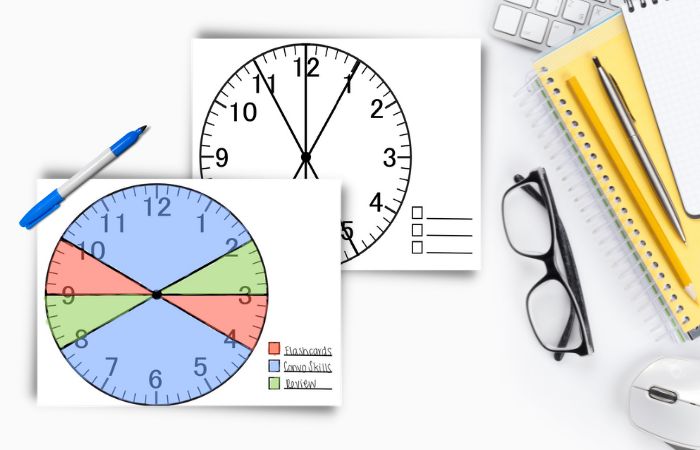
Reducing Verbal Instructions
I knew that we needed to get out of the house at a specific time and the speech path in me thought, okay, I’m going to approach this as I would with a student on my caseload.
So first, I began by reducing the amount of verbal load I put up my children.
First, I would say something like “It’s time to go, please put your shoes on”.
Then, once my boys had still not put their shoes on, I would say something like, “Put shoes on”.
I eventually got to “shoes” with a visual cue of pointing to the shoes.
However, sadly, this was still causing a lot of struggle. So I took the next step – a visual schedule!
I remembered how effective visual schedules were with my caseload, and was inspired to make a resource for teachers, speech therapists, and families alike to use.
Visual schedules are graphic representations of tasks and activities that will help our students understand what to expect during a session. The use of a visual schedule helps make our sessions (and just our overall lives) more organized.
They come in various formats, but I personally love using a dialog clock and some fun coloring to help students create their own schedules!
Key Takeaways
- Visual schedules are a crucial tool in speech therapy, helping structure sessions and making them more organized.
- Customization and integration of visual schedules cater to the needs of different age groups and communication disorders.
- Effectively designed visual schedules are a perfect solution to enhance engagement and improve the overall efficiency of speech therapy.
- How to make visual schedules
Understanding Visual Schedules and Their Role in Speech Therapy Sessions
Visual schedules are an essential component in speech therapy. They are effective for young students, older students, and especially for students with anxiety and receptive language skills.
The graphic representations of tasks and activities make it easier for students to understand what is coming next.
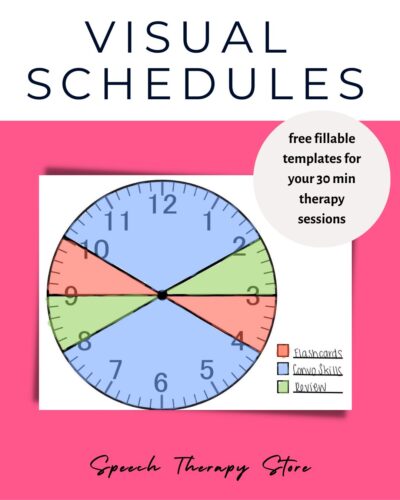
Benefits of Visual Schedules:
- reduces anxiety and frustration
- helps structure sessions
- provides clear expectations for our students
- assist in transitioning between tasks (which reduces challenging behaviors!)
- can be tailored to the child’s needs and abilities
- promotes independent living skills
- as they become familiar with the visual cues, students grow in confidence in navigating their routines
- can be integrated into therapy sessions and into daily lives (morning routines, after-school activities, meal planning, etc)
Using Visual Schedules for Transitions
As a therapy tool, visual schedules help us transition smoothly between activities in our speech sessions.
Through this method, we can see a reduction in challenging behaviors from students who might struggle with abrupt changes.
By outlining the sequence of the session schedule, we make it clear what’s expected of them and help them feel more secure in their environment.
Using Different Visual Schedule Formats to Meet our Students Needs
We use different formats of visual schedules depending on the needs of our students.
Some may benefit from physical visual schedules mounted on walls, while others might prefer electronic visual schedules on their smartphones or tablets.
These different formats cater to diverse learning preferences and make it accessible to as many students as possible.
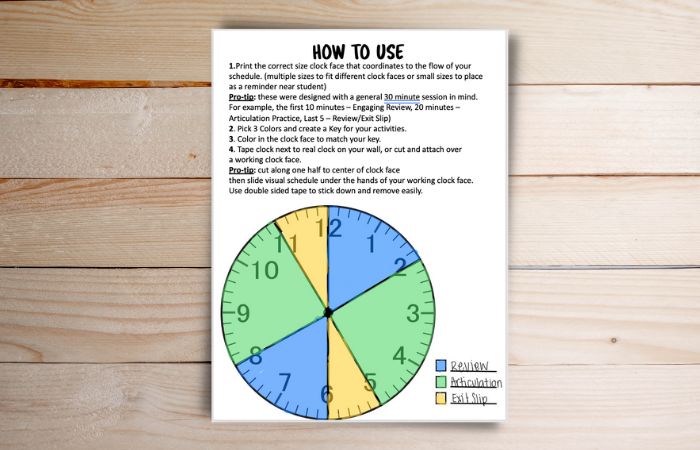
Visual Schedules can be Helpful for Any Student
In our experience, visual schedules are not only beneficial for neurodiverse students but also for young neurotypical students.
By incorporating visual schedules in our therapy sessions, we can address multiple learning styles and support the needs of all our students.
This inclusive approach has proven extremely effective in promoting progress and success in speech therapy.
The use of a visual schedule serves as a valuable tool for creating an organized and predictable therapy environment, ultimately contributing to more successful and engaging therapy sessions for our students!
Specific Uses of a Visual Schedule for Speech Therapy
Visual schedules are an invaluable tool for speech therapy, particularly for individuals with autism spectrum disorder and special needs.
The use of visual schedules help create structure and predictability, fostering a sense of security for our students. In this section, we will discuss the specific uses of visual schedules in speech therapy.
Visual Representation of Speech Therapy Session
By presenting the sequence of events in a clear and visually appealing way, we enable our clients to better grasp and retain the information.
In my speech therapy sessions, I would often incorporate visual schedules into my lesson plans. For example, I would use a visual support that displayed the order of activities in my lesson plan. Such as articulation oral placement review, articulation practice, reward, and an exit ticket.
By providing clients with a tangible representation of the session’s structure, they are empowered to anticipate what comes next, reducing anxiety and promoting engagement in the therapy process.
Win-Win!
Side Note: A visual schedule could also be helpful for special education teachers within their special education rooms, or for occupational therapists during occupational therapy sessions, or physical therapy sessions to help our students know what’s next and what to expect.
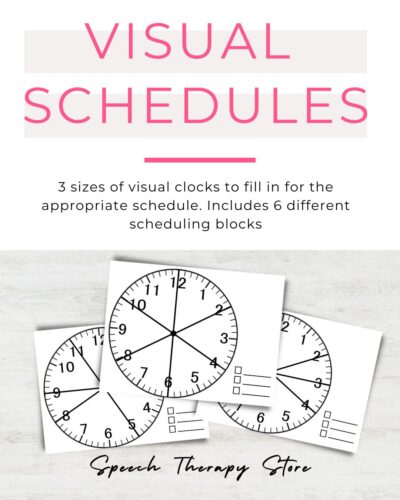
Independent Work Tasks
We’ve also witnessed great success in using visual schedules for independent work tasks. These resource types help our clients develop essential life skills and build a sense of autonomy.
For instance, we might use a visual schedule outlining the steps for completing a self-care activity, such as brushing teeth or getting dressed.
By following the visual schedule, our clients gain confidence in their ability to perform and complete tasks independently.
This can also be extremely helpful for our students during vocational education who are learning to complete specific tasks to join the workforce.
Practicing Time Management Skills
Aside from their therapeutic benefits, visual schedules also serve as an effective visual timer.
By setting a clear visual representation of time (one of those difficult-to-grasp abstract concepts), our clients become more aware of the passage of time and develop a better understanding of the time available for each activity.
This is a great way to help reduce anxiety associated with transitions and improve overall time management during sessions.
Speech Therapy for Different Age Groups
Early Intervention and Speech Therapy
In early intervention, we focus on providing speech therapy for children aged 0-3 years old. During these crucial years, children develop foundational communication skills. It’s essential to address speech and language concerns for a smoother transition into school-age years.
Visual schedules can be helpful for young children, as they provide structure and predictability to therapy sessions.
Visual Schedules for Elementary Students
For elementary students, including 1st grade and other grade levels, visual schedules are an excellent tool in speech therapy. At this age, children are developing their reading, writing, and social skills.
Visual schedules help them understand the plan for each session and give them a sense of control. We can use formats like:
- Tables
- Bullet points
- Bold text for emphasis
For example, a visual schedule for a session might include:
- Warm-up activity
- Reading passage
- Language game
- Review and wrap-up
This format makes it easier for students to follow the activities and know what to expect.
Implementing Visual Schedules in Middle and High School
As students enter middle school and high school, the complexity of speech therapy sessions increases. Older kids may require more advanced strategies and materials.
However, visual schedules can still be beneficial at these grade levels. They provide a clear plan and enable students to track their progress throughout the session.
In middle and high school speech therapy sessions, we might include activities like:
- Group discussions: to encourage social communication skills
- Role-plays: to practice using target language concepts in context
- Problem-solving tasks: to enhance critical thinking and expressive language skills
By incorporating visual schedules, we can support our middle and high school students in improving their communication skills and navigating social settings with confidence.
SEE ALSO: 432+ Free Measurable IEP Goal Bank

Customizing Visual Schedules
With all this in mind, I decided to create a visual cue for my own children! I wanted them to have a visual representation of the time and activities that we needed to do.
Here is what I did: (I wanted to note here too, that this worked wonderfully at home for my boys, I have adapted this idea into an easy-to-go Freebie for you!)
I bought a cheap clock from Walmart and colorful Sharpies.

I decided that I wanted to have the boys involved in creating the visual clock so that they could take part and have ownership in what the colors represented and the amount of time they got to do per activity.
My thought was that on most days I like to get out of the house and I figured if we left at 30 after the hour that would give me a half hour to get somewhere at the hour.
With this in mind, we began our clock making!

My goal was to work backwards. I wanted to have the boys in the car by 20 after the hour.
This would give me a 10-minute wiggle room to have them in the car at least by 30 after, therefore giving us a 30-minute drive to wherever we wanted to go and whatever activity we wanted to do that day.
With that in mind, I then asked the boys how much time they would like to get ready to get into the car. They thought five minutes was enough.
Side Note: Looking back I think I would have made it 10 minutes. But for now, it’s at five minutes and they chose the color purple.
Then we colored 15 to 20 after the hour the color purple.

We continued to work backwards from there.
Getting them dressed has been a big struggle as well. So I decided to put a 10-minute TV time in between us having to leave and the boys getting the reward for getting dressed.
They decided on the color yellow. They thought 10 minutes was a good amount of time as a reward for getting dressed and eating breakfast.
Side Note: We’re currently on day three of using the clock and the 10-minute TV time has worked out really well.
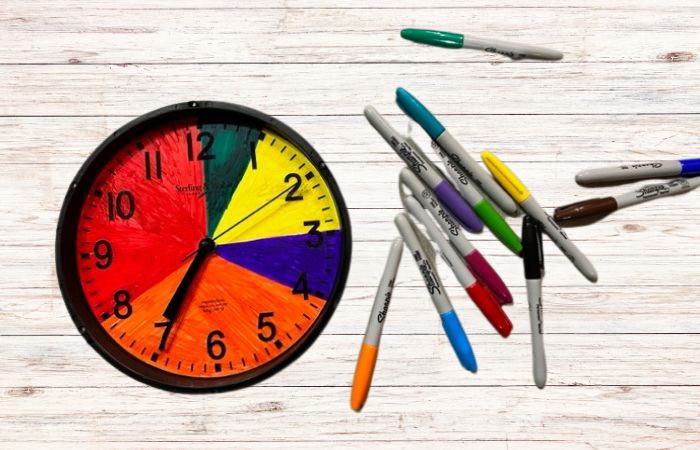
At first, they took extra time getting dressed and it fell into the yellow time. They ended up only having two minutes of TV time the very first day we did this because it took them so long to get dressed.
After a quick meltdown, I reminded them that they could try again the next day to enjoy more of the yellow TV time.
They then had eight minutes the following day. And by the third day, they had earned all 10 minutes of TV time because they were watching the clock and they knew they had five minutes of getting dressed before they earned their screen time.
Above the getting dressed time we have eating time which is a 20 minute slot in the color red.
Prior to eating they have another 20 minutes of play time colored orange.

Visual Schedule Clock Results
So far, the boys are loving this idea.
We actually have decided not to hang it up on the wall because the boys take the clock around with them once we have started tracking.
If we need to leave, they will carry it around and say okay, now it’s time for such and such activity. One might say, “Okay, now it’s time to get dressed.”
So they seem to love having the visual and watching the hands go by and watching when they get to the different colors.
Today, even one of my boys said, “Okay TV time is over” he then grabbed the remote and turn the TV off. Which for a four and a half year old is a pretty big deal!
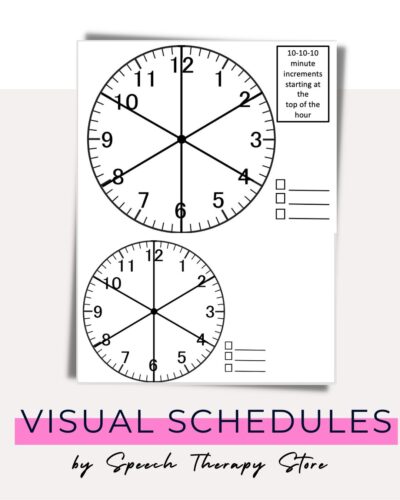
How to Create a Visual Schedule for Speech Therapy with a Visual Clock
I wanted to take this concept and apply it to be used in a speech therapy room, but I also wanted to make this process as simple as I could for you, the busy speech therapist, but also fun and engaging for our students!
Below is a Freebie of Pre-Made Visual Schedules for your students. They are designed to be 30 minute schedules, with 10-15-5, 10-10-10, and 5-20-5 minute variations starting at both the top of the hour, and at the quarter hour mark.
Step 1: Print out and Color
Print these out and color code them with your students (get them involved in making these – it will empower them and increase independence and understanding of the schedule!).
Color code them in a customized way to meet your student’s individual needs!
Step 2: Attach to Clock
Next, you can either cut out the customized clock face and use double sided tape or velcro dots to attach it to a working clock face, under the hands. Line it up so that the hands will travel over the visual schedule at the correct time frames.
OPTIONAL: Other Options to Place Visual Clock
Another option is to cut out the visual schedule and key, and tape it right next to a working clock, or place it near the student’s workplace to reference as time passes and you are moving to the next activity.
The goal of this visual clock is to hopefully help give our students a visual representation and help them transition between different tasks.
By creating the clock together it can give our students some ownership and control over where the schedule is and where the schedule is going.
SEE ALSO: Free SLP Planner [Updated Yearly]

Additional Customized Visuals
To create the most effective schedules, we recommend customizing them to cater to the individual needs and preferences of each child. In this section, we’ll go over some strategies and resources you can use to personalize your visual schedules.
Decide on the Type of Visual Schedule for Speech Therapy
First, consider the type of visual schedule that best suits the child. We have loved using our visual clock schedule, but there are many other options:
- Picture Cards – Can be printed and laminated.
- Digital Schedules – These can be created on devices like tablets or smartphones.
- Schedule Board – This can be a physical board with images attached using hard Velcro or a whiteboard with custom illustrations.
Decide on Visual Schedule Content
Next, decide on the content of the visual schedule.
A schedule of the day might include an overview of the activities planned for the therapy session, while a more detailed schedule might break down each activity into smaller steps.
Consider the child’s age, cognitive ability, and language skills when selecting appropriate images and tasks.
Using Real Images Personalized for the Student
To add more variety and personalization, we recommend using different resources for obtaining images.
We have seen visual schedules with pictures from a boom cards deck that they will be working through, or an example of their flash cards.
Showing a quick image of the activity is a powerful tool to incorporate with the use of visual schedules.
Consider Child’s Interests
When creating visual schedules, it’s essential to consider the child’s interests and preferences.
For example, if a child enjoys superheroes, use superhero-themed images to represent tasks on the schedule.
Alternatively, consider taking your own pictures or creating custom images to represent activities more accurately. Using familiar and engaging visuals can increase the child’s motivation and make the schedule more relevant to their everyday lives.
Showing Clear Endpoints on Your Visual Schedule
Lastly, it’s important to ensure every task on the schedule has a clear endpoint.
By following these suggestions, we can create customized visual schedules that effectively support children’s progress in speech therapy, making the whole process more enjoyable and engaging for everyone involved.
Side Note: Visual Schedule for Speech Therapy on a Particular Day
A visual schedule is also an effective way to handle a complete change in a child or student’s schedule that doesn’t happen very often but can be a complete disruption to their typical schedule causing unnecessary anxiety.
For example, creating your child or student an individual schedule for one-off activities such as field trips, fire drills, or other specific activities can be extremely helpful.
SEE ALSO: Lesson Plans for Speech Therapy
Final Tips for an Effective Visual Schedule for Speech Therapy
- carefully consider the individual needs of a student
- understand the student’s visual stage as related to their comprehension level
- organize the schedule in a meaningful sequence (this establishes consistency and predictability)
- keep it clear and simple
- make sure the visual schedule is flexible and easy to modify as needed
Grab Your Free Visual Schedule for Speech Therapy Templates Here!
Simply enter your name and email to have these Free Visual Clock Templates emailed directly to your inbox!
Frequently Asked Questions
What are the benefits of a visual schedule in speech therapy?
Visual schedules are an essential tool in speech therapy, as they provide clear expectations and reduce anxiety for students. They aid in improving communication, organization, and independence. Additionally, visual schedules help students with autism, anxiety, or lower receptive language skills comprehend what is coming next, reducing frustration and increasing engagement in therapy sessions.
How do I create an effective visual schedule for therapy?
To create an effective visual schedule, first, identify the tasks and activities that will take place during the session. Use simple and clear images or picture symbols to represent each task. Arrange these images in the order they will occur, ensuring the format is easy to understand and follow for the student. You can create a physical schedule to hang on the wall or an electronic schedule on a smartphone or tablet. Be sure to review the schedule with the student before and during the session to help them stay on track and understand their progress.
What are some examples of visual schedules for students?
Visual schedules can be tailored to meet each student’s unique needs and preferences. Examples include daily schedules displaying the sequence of events in a school day, a first-then board to help students understand the order of two activities, or visual session schedules outlining the lesson plan for a therapy session. The format may vary – from printed images on a whiteboard to digital schedules on an electronic device.
How do visual schedules aid in special education?
Visual schedules are crucial in special education as they offer structure and predictability to students who may struggle with routines or transitions. They promote independence, allowing students to understand and navigate their day more effectively. Visual schedules also help students with communication difficulties by providing them with a clear, visual representation of what is expected during an activity or day.
What is the role of visual schedules in school settings?
In the school setting, visual schedules serve as a support system for students with special needs, such as autism spectrum disorder or other cognitive and emotional differences. They help students transition smoothly between activities, improve time management, and reduce anxiety related to uncertainties. With clear expectations provided, visual schedules enable students to participate more fully in school activities and improve their overall educational experience.
Want Even More Lesson Plans for Speech Therapy?
- Free SLP Planner [Updated Yearly]
- 917+ Best Free Boom Cards for Speech Therapy
- 31 Best Wordless Videos to Teach Problem Solving
- 133+ Categories List for Speech Therapy
- The Best Handout for Phonological Processing Disorder Therapy
Want the Best of the Bests?
Be sure to check out our most popular posts below!
- 21 Best Reinforcement Games for Speech Therapy / Teletherapy
- Best IEP Resources
- 71+ Free Social Problem-Solving Scenarios
- 430+ Free Multisyllabic Words List Activity Bundle
- 432+ Free Measurable IEP Goals and Objectives Bank
- 279+ Free Speech Therapy Digital Materials
- 179+ Free Speech Therapy Wh-Questions Printable
